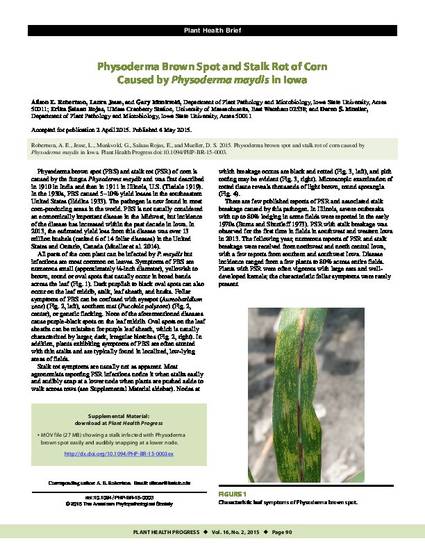
Article
Physoderma Brown Spot and Stalk Rot of Corn Caused by Physoderma maydis in Iowa
Plant Health Progress
Document Type
Article
Disciplines
Publication Version
Published Version
Publication Date
5-4-2015
DOI
10.1094/PHP-BR-15-0003
Abstract
Physoderma brown spot (PBS) and stalk rot (PSR) of corn is caused by the fungus Physoderma maydis and was first described in 1910 in India and then in 1911 in Illinois, U.S. (Tisdale 1919). In the 1930s, PBS caused 5–10% yield losses in the southeastern United States (Eddins 1933). The pathogen is now found in most corn-producing areas in the world. PBS is not usually considered an economically important disease in the Midwest, but incidence of the disease has increased within the past decade in Iowa. In 2013, the estimated yield loss from this disease was over 13 million bushels (ranked 6 of 14 foliar diseases) in the United States and Ontario, Canada (Mueller et al. 2014).
Copyright Owner
The American Phytopathological Society
Copyright Date
2015
Language
en
File Format
application/pdf
Citation Information
Alison E. Robertson, Laura Jesse, Gary Munkvold, Ericka Salaau Rojas, et al.. "Physoderma Brown Spot and Stalk Rot of Corn Caused by Physoderma maydis in Iowa" Plant Health Progress Vol. 16 Iss. 2 (2015) p. 90 - 92 Available at: http://works.bepress.com/alison-robertson/264/

This article is published as Robertson, A. E., Jesse, L., Munkvold, G., Salaau Rojas, E., and Mueller, D. S. 2015. Physoderma brown spot and stalk rot of corn caused by Physoderma maydis in Iowa. Plant Health Progress 16: 90-92. doi: 10.1094/PHP-BR-15-0003. Posted with permission